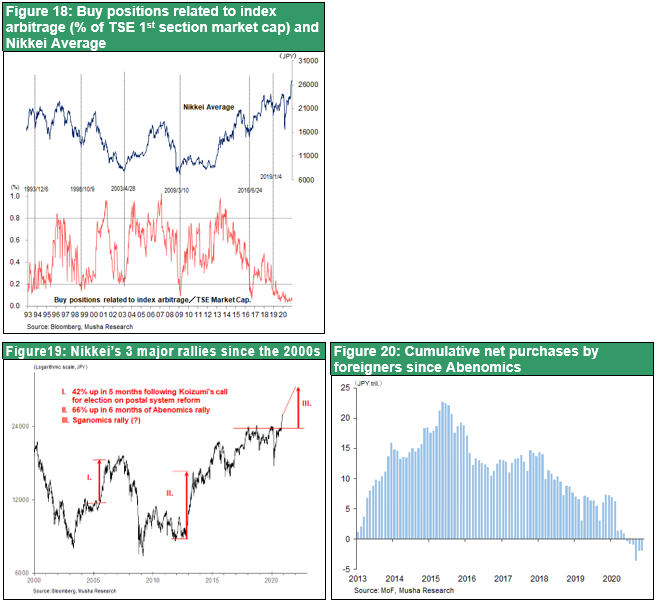Jan 01, 2021
Strategy Bulletin Vol.269
2021 will be the starting point for an upswing in short/medium/long/super-long term economic cycles
~Bet on a boom this year
We take this opportunity to wish you all the best for the new year.
Starting point for discussion: why the market overcame the black swan event
In looking ahead to 2021, it is of utmost importance to recognize the fact that the market and its fundamentals overcame the black swan event (the unprecedented COVID-19 pandemic) in 2020. The stock market has made a V-shaped recovery, clawing back a 40% collapse in just five months, and continuing to climb. Since stock prices are the most reliable leading economic indicator, it is almost certain that 2021 will be a year of strong economic growth. Yet, some criticize the current stock market as being in a bubble and refer to it as a "false dawn”. The same argument was prevalent around 2010-2012, after the Global Financial Crisis. However, such pessimism is as unfounded today. It is true that policy support has contributed to the stock market rally and economic recovery, but it was wrong to argue that the policies were wrong and would fail. This time, too, the argument that market-friendly policies are wrong and will fail is not convincing, as we will explain in detail below.
Two Major Factors: Value Creation and Policy Capabilities
Why are markets and economies able to overcome such a crisis? The two essential reasons are as follows.
- The economy is strong, i.e., productivity has increased due to the Industrial Revolution, and healthy value creation continues.
- The wisdom of policy has successfully blocked the black swan event that would have led down a path of economic collapse (evaporation of demand and freezing of supply capacity). More specifically, it has been possible to completely shelve the liquidationist economic policies that led to the prolonged stagnation during the Great Depression and following the collapse of Japan's bubble economy. It is clear that we would have fallen into a major recession if not for the strong integrated fiscal and monetary easing policies. This is a victory for economics and economic policy, especially in the US and the UK. The main argument of Japanese academics, economists, and the media is "What are we going to do about this unrestrained budget deficit and monetary easing?”, with Japanese public opinion being formed in the wrong direction. We need to be careful.
COVID-19 is still rampant. However, the vaccine roll-out has begun. Vaccines from Pfizer, Moderna, AstraZeneca, and others all have high efficacy and limited side effects, so it is highly likely that COVID-19 could be contained by the second half of 2021. Musha Research believes that 2021 is likely to be the starting point for an upswing in the short-, medium-, long-term, and super long-term economic cycles. The Chinese economy and the US-China conflict are the biggest risks, but they will not become apparent in the short term.
In 2021, the long-term upward trend in the US stock market, which has continued since 2009, will remain unchanged. With the ongoing rise in global stock markets, Japanese stocks in particular will enjoy one of the largest tailwinds of the past 20 years.
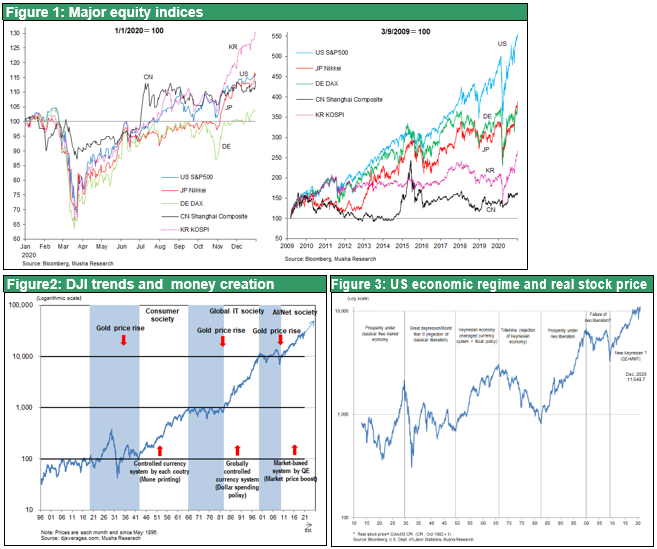
(1) Short-term economic cycle was alive
The coils of the short-term cycle are ready to spring
The year 2020 was supposed to be the year of recovery in the global manufacturing business cycle, which peaked in the spring of 2018 and bottomed out at the end of 2019. There are mini-cycles even in the midst of long-term economic expansion, and this impacts markets such as interest rates and stock prices. Figure 4 presents the trend in the mini cycle for the US manufacturing sector and long-term interest rates. It shows recent peaks in the spring of 2015, a bottom during 2016, a peak in the spring of 2018 and a bottom in the autumn of 2019. The mini-recession that began in mid-2018 was caused by the replacement cycle of smartphones and automobiles, and the shelving of investment projects due to the US-China trade war. The bottom of the mini cycle was extended even further due to COVID-19, which took hold just after the bottoming out of the mini-recession. However, this means even greater potential strength has been stored for a rebound in 2021.
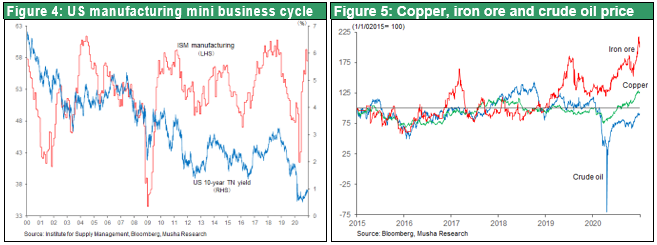
The mini business cycle of the past three to four years has been a manufacturing business cycle led by trade, investment, and durable goods consumption. In the manufacturing sector, China is now the world's largest market for automobiles, smartphones, steel, and cement (the size of China's manufacturing market is almost double that of the US), and China is creating more waves in the global manufacturing business cycle than the US. The decline in the global economic mini-cycle since 2018 has been driven in large part by deteriorating domestic demand in China, and we are now in the midst of a sharp reversal. Demand for automobiles, the main cause of the downturn, has bottomed out, and demand is being boosted by infrastructure investment in response to COVID-19 and real estate investment due to monetary easing.
Unleashing pent-up desire and savings
In addition, there are accumulated desires and savings (so-called "pent-up demand") all over the world, which are expected to be unleashed when COVID-19 comes to an end. We anticipate unprecedented upward pressure on the short-term cycle in the second half of 2021.
Soaring commodity prices, signs of shortages in semiconductors and other products
Commodity markets for iron ore, copper, and aluminum have already recovered to levels not seen in seven years. In addition, there are concerns about the emergence of capacity shortages in the semiconductor, LCD, and other device sectors. Demand for terminals, data centers, and other infrastructure is surging due to the demand for remote working generated by COVID-19, while investment in new technologies such as 5G has begun, leading to increased investment in cutting-edge semiconductors to stay ahead of the competition. China is poised to outperform other countries in terms of 5G investment, and investment in 5G high-tech is surging in China, with other countries following suit and beginning to compete for investment.
Various countries have successively upwardly revised their economic forecasts. Between September and December, the US Fed revised its GDP growth rate for 2020 from -3.7% to -2.4% and for 2021 from 4.0% to 4.2%. The Bank of Taiwan also revised its GDP forecast for this year from 1.6% to 2.6% and for next year from 3.3% to 3.7% between September and December. Even Australia, which has been under pressure from China through trade sanctions and other measures, raised its GDP forecast for FY2020 from -1.5% to +0.75%. It is believed to be benefiting from the rise in iron ore prices.
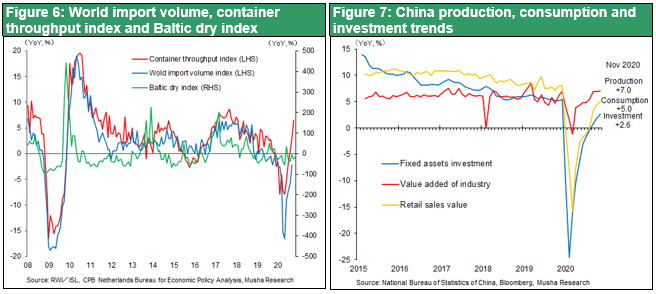
Subtle changes in US monetary policy will set off a chain reaction in financial markets
This rapid recovery in short-term business sentiment will first raise inflation expectations in the US and bring about signs of a change in the monetary policy stance (with caution), which will no doubt spread to the financial markets as a whole. In the stock market, this will boost value stocks, which are sensitive to the economy. In the bond market, this will boost long-term interest rates. In the currency market, it will bring about a bottoming-out of the dollar.
A trend shift with a preference for value stocks, higher long-term interest rates and a stronger dollar
The consensus in the international financial markets is that the dollar is weakening. This is because the US has launched the most aggressive monetary and fiscal easing program in the world, and there is an abundant supply of dollars. In addition, the fact that the US real interest rate (i.e., the yield on inflation-linked bonds) has fallen to -1.2%, the lowest in the world, under the zero interest rate policy, has greatly supported the argument for a weaker dollar. The real interest rate differential is considered the most important trend-determining factor in the foreign exchange market, and this decline in the US real interest rate has determined the expectation for the dollar's depreciation. However, the cause of the sharp decline in real interest rates in the US is not zero interest rates. Short-term policy rates are near zero not only in the US but also in Japan and Europe. The reason for the remarkably low real interest rates in the US is that inflation expectations in the US did not decline at all even under COVID-19. As seen in Figure 8, the long-term expected inflation rate (10-year Treasury yield - TIPS) in the US has already returned to pre-COVID-19 levels at 1.6-1.8%, suggesting that the underlying strength of inflation in the US economy is very strong. The US has the strongest confidence in its economic growth among advanced economies, and hence high inflation expectations, which is pushing down real interest rates in the US even further.
This aggressive fiscal and monetary easing and strong confidence in the economy foresee the US having the strongest economic recovery amongst advanced economies. If we see a monetary policy shift under this scenario, the dollar will strengthen.
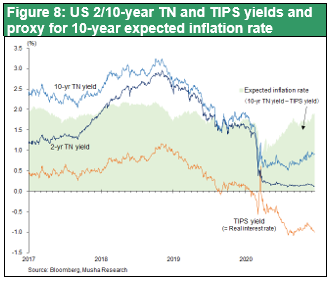
(2) Rising medium-term economic cycle caused by MMT, will prove its effectiveness
MMT is a key contributor to repelling the black swan vent
In the medium term, the introduction of Modern Monetary Theory (MMT) through fiscal and monetary integration will be successful and take root, and we will enter a period in which business-friendly large-scale fiscal and monetary easing in advanced countries will enhance economic growth. As mentioned above, the market was able to overcome COVID-19 because it did not hesitate to adopt the "forbidden" policy of MMT.
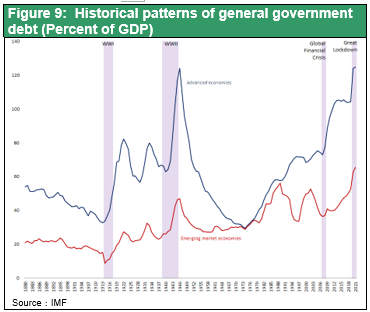
If not for COVID-19, MMT would not have been adopted
Due to the need for emergency response to COVID-19, MMT has effectively taken root in each country as the only countermeasure. The integration of fiscal and monetary policy, in which massive fiscal expenditures are financed by central bank purchases of government bonds, is a form of fiscal finance that had previously been considered forbidden and can be described as MMT itself. According to an IMF survey, the government debt of advanced countries has risen to the highest level in history (Figure 9), but this would not have been possible without the cooperation of central banks. Figure 10 shows the US budget deficit and the increase in central bank balance sheets (YoY increase), as prepared by Mr. Yardeni (President of Yardeni Research), a colleague of mine during my time at Deutsche Bank. It can be said that the central bank's purchases of government bonds helped stabilize long-term interest rates at a low level without causing crowding out, stabilizing the market and also meeting the demand for private-sector funds.
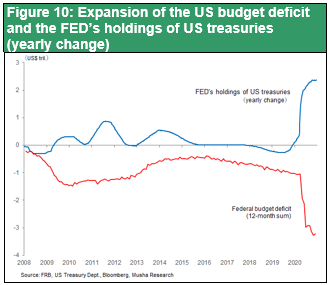
Japan has also been in alignment with the introduction of MMT
As shown in Figure 11, fiscal finance, effectively MMT, took root in Japan as a result of the current pandemic. It is sometimes argued that Japan was the first country in the world to implement de facto MMT, but this is not necessarily true. During Governor Shirakawa’s tenure at the BOJ (2008-2013), the BOJ's holdings of government bonds increased only modestly despite the increase in the budget deficit and there was no fiscal financing. In other words, the demand for fiscal funds put pressure on private-sector finance and pushed up market interest rates. On the other hand, quantitative easing (QE) was implemented under Governor Kuroda’s BOJ since 2013. This was conducted by the BOJ to take over the huge amount of government bonds held by private banks, Japan Post Bank, GPIF and other financial institutions, and was not fiscal finance. In the first place, under Abenomics, austerity measures were implemented such as two consumption tax hikes and primary deficit reduction, and no additional demand for fiscal funds was generated. Therefore, integrated fiscal and monetary easing has been realized for the first time in Japan under the current COVID-19 crisis.
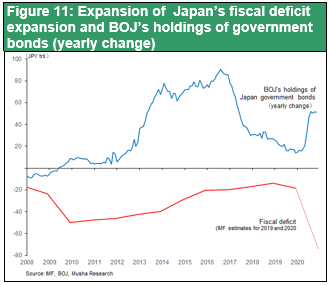
In Europe as well, the ECB has been purchasing Italian and Greek government bonds through a massive expansion of its balance sheet, thus realizing a spectacular fiscal and monetary union.
Introduction of MMT, the best prescription for excess supply and excess savings
The introduction of MMT, which has already taken root in advanced countries, has been criticized for causing higher interest rates and inflation, which would lead to government bankruptcies, but for the time being, such fears are unfounded. Before the COVID-19 outbreak, the world economy was facing two fundamental problems: downward pressure on prices = lack of demand, and downward pressure on interest rates = too much savings. The shortage of demand was caused by the technological revolution of the internet, AI, and robotics, which boosted productivity and increased supply capacity. The decline in interest rates was caused by high corporate profits (value added by companies due to higher productivity) and excessive household savings, which delayed purchasing power. Therefore, it was necessary to stimulate demand by utilizing surplus funds through both expansionary fiscal and monetary policies. If the pandemic is an opportunity to utilize the capital and supply that have been idle, the economy should improve to better levels than before COVID-19.
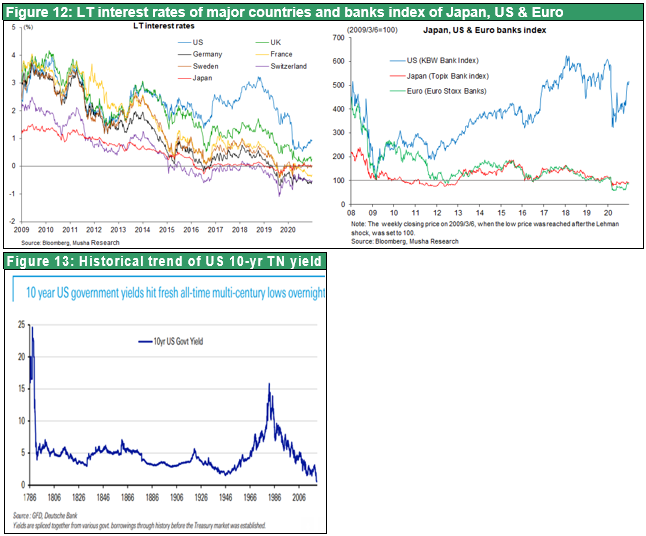
MMT advocates argue persuasively that the obsession of academics, the media, and economists with the idea that budget deficits are bad has led to destructive policies in economies with large surpluses of supply and savings, such as Japan and other advanced economies today, that are not based on fundamental analysis. (For example, Professor William Mitchell, Newcastle University, "The Corona Crisis and Fiscal Expansion (1)," Nikkei Inc. Economic Classroom, December 22, 2020)
MMT likely to succeed and become a new means of financing
Musha Research believes that there is a strong possibility that the current fiscal financing (MMT) of advanced countries will achieve its policy objectives without a collapse. In the US, in particular, the animal spirit is still alive and well, as (1) lower interest rates lead to higher housing demand, and (2) the expected inflation rate has hardly declined even under COVID-19. There is a strong possibility that fiscal and monetary support will greatly boost demand, narrowing the output gap and realizing the Fed's desired 2% inflation target. In this process, long-term interest rates are likely to rise above 2%. In this way, MMT will prove its policy effectiveness and become an established means of financing spending in areas such as education, new technology development, and new social safety nets.
(3) Long-term economic cycle, digital net revolution in full swing
The three conditions for innovation (technology, needs, and capital) are in place
COVID-19 has perfectly prepared the three conditions for innovation: technology, market (needs), and capital (risk capital). The technology to digitize all human activities online already existed, and there was plenty of capital, but the needs were lacking. However, COVID-19 brought about an urgent need for most business and daily life to be conducted on the internet, such as working from home, online classes, and home medical examinations, and a market need was quickly formed. As a result, the trend toward digital transformation (DX) has become evident, and competition for investment in the online digital revolution is developing in order to stay ahead of innovation.
The online digital market is moving from personal use to infrastructure
In addition, the beginning of the 5G era has changed the phase of the online digital revolution. Global demand for personal devices such as smartphones, televisions, and PCs has already peaked, and the demand for devices is shifting toward infrastructure and business use.
Increasing importance of cyber-physical interfacing, where Japan is strong
With the development of IoT and digital network applications, the focus is shifting from the traditional cyber business model to the cyber-physical interface, which is the interface with the real world. This has expanded the business opportunities in areas where Japanese companies are strong such as components, materials and equipment as well as analog IC and power semiconductors. Until around 2015, Japanese companies continued to lose market share to Korean, Chinese, and Taiwanese companies in the field of mass-produced electronics such as semiconductors and smartphones. However, the environment has changed since then. Japan's wage growth rate is lower than Korea, Taiwan, and China, and its currency is weaker, so Japan's price competitiveness is starting to recover.
In addition to the global economy, Japan is also pushing forward with its digitalization, which had been lagging behind, through the establishment of the Digital Agency. Investment in digital networks is expected to drive up the wave of long-term economic growth.
(4) Dramatic reduction of work hours will boost consumption power in the super-long economic cycle
Diversification of labor forms, dramatic decrease in work hours
The era of physical group work and group education is coming to an end. Remote work and flexible work will become the norm, and work hours will decrease dramatically. This will greatly increase consumption power.
As stipulated in Convention 1 of the International Labor Organization (ILO), established in 1919, the 48-hour working week has not been achieved even after 100 years. Despite a tenfold increase in labor productivity over the past 100 years, the number of hours worked by mankind has remained virtually unchanged, and the balance between production and consumption has been severely disrupted. As can be seen in Figure 16, it is curious that while human technology and productivity have increased so much, only work hours have not changed much since the Middle Ages.
Many of the problems advanced countries today can be attributed to factors such as overproduction, excess supply capacity, excess capital (=savings), deflation, and zero interest rates. In other words, even though productivity (=supply capacity) has increased remarkably compared to 100 years ago, leisure time, which is the foundation of consumption, has not increased at all. So the root cause of all the problems lies in the stagnation of consumption power. Now that demand for goods has reached saturation point and service consumption has become the center of demand, leisure time must be further increased in order to stimulate demand.
Long work hours also make it difficult to manage families and raise children. The biggest reason for the sharp decline in birth rates in Asian countries such as Japan, South Korea, and China, which have been catching up with advanced countries, may be the long working hours and inflexibility of work patterns.
The dramatic changes in work organization triggered by the COVID-19 pandemic will correct 100-years of work-life balance (work hours vs. consumption hours). It will also fundamentally change human relationships and organizational forms (see Figure 17).
From the Industrial Age to the Cyber Age
The aforementioned phenomena are not occurring in isolation. A new social stage following the primitive gathering economy, agricultural economy, and industrial economy has begun to emerge as a result of the digital network revolution. It is conceivable that human society has begun to fundamentally depart from the organization based on the factory-based machine industry at its core.
This will cause a dramatic shift in the form of value creation. Where does value come from? It comes from differential land rents. Under two different production conditions (e.g., fertile land and thin land), if there is a difference in output, the additional value generated from the fertile land is the value added. The cost of using the fertile land was the differential land rent that was added. The element that brings this added value is now changing from land in the agricultural era and machinery (capital) in the industrial era to cyber wisdom. Value creation is no longer done on land as it was in the agricultural age or in factories (offices) in the industrial age, but now done on the internet and in cyberspace. It is now in the cyber world that technological innovation is advancing at the fastest pace and productivity is increasing. We do not know what kind of social changes will be brought about by the cyber wisdom. But it is clear that we are living in an age where the effectiveness of the economics and economic policies that have dominated the last few hundred years has reached its limits. We are now standing on the threshold of a new era of humanity, and it is likely to be an era full of new dreams and opportunities.
The Internet will make market principles and democracy more effective
With the internet, all economic resources will find their customers on the internet and will be valued at appropriate prices. The internet will further enforce market principles, and God's invisible hand will spread to more granular details. This means that markets will become more efficient and productive. In addition, the internet will greatly reduce the cost of living and create an income surplus. It seems that we are entering an era in which live performances, actual experiences, and human contact will have value. The boundary between labor and consumption has become blurred. We are beginning to see what Toffler called prosumers.
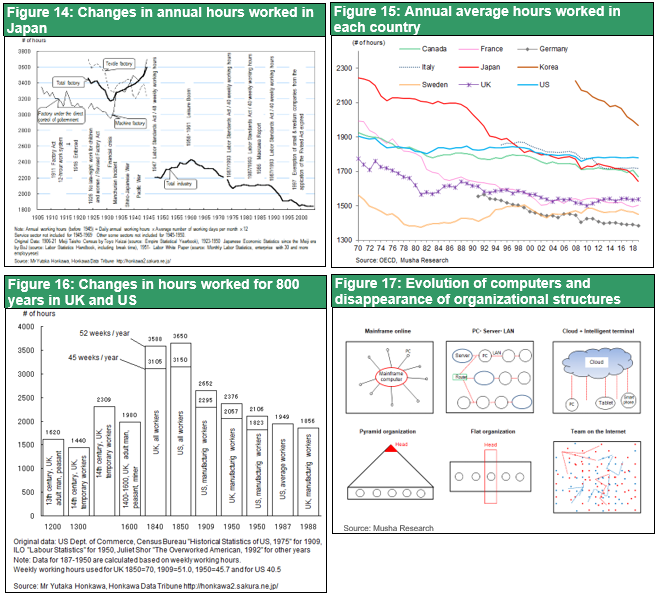
(5) Risk that the largest manufacturing nation, China, will begin to be excluded
Exclusion of non-democratic China is underway, but the Biden administration will also pursue economic interests in China
The biggest risk in 2021 will be China-related. It delayed the initial response to the COVID-19 pandemic by controlling information, causing a global pandemic; it has blocked democracy and violated human rights in Hong Kong and elsewhere; and it has used its economic power as a means to realize the political intentions of the Communist Party. If we call this Stalinism, the world will not be able to coexist with China.
But on the other hand, China is the world's largest producer of all kinds of goods, with a 55% share of crude steel production. With a manufacturing market twice as large as that of the US, China is the world's largest consumer of goods. Companies cannot survive without this huge market. If this dichotomy tilts in the direction of the former, the risk of serious economic damage cannot be ignored.
Biden's response to China is a hybrid
We believe that Mr. Biden will deal with China using a hybrid, or double standard, approach. He will strengthen sanctions against China from the perspective of national defense and security but maintain or strengthen relations with China from the perspective of economic and corporate interests. The confrontation between the US and China will remain unchanged, but there is a great possibility that it will become more orderly. In an article in the Wall Street Journal, former Treasury Secretary Henry Paulson argued that "economic power is the key to surpassing China, and we cannot win the battle for high-tech supremacy without protecting the interests of US companies”. By providing special benefits to foreign companies, especially US companies, China is trying to break the US government's hostile policy. Goldman Sachs, BlackRock and others have established wholly owned subsidiaries in China. Tesla, too, lured by the sweet talk of establishing a wholly owned subsidiary, is building a Gigafactory in Shanghai to strengthen its EV supply chain in China and participate in plans to export cars from China.
Japanese companies should maintain and expand their presence in China's manufacturing market, which is twice the size of the US market, while seeking rules-based grounds (clarification of refusal to deal for national security reasons). The competitiveness of each country's industries is now largely supported by preferential government policies that go beyond the efforts of individual companies, and a cunning response is required. Japan has become critically important to the US and China, both from a geopolitical perspective and from the perspective of the international division of labor. Japan should make full use of its advantageous bargaining power. For example, Japan's resolute response has put South Korea in a tight spot because of Japan's dominant geopolitical and international division of labor position.
(6) Japan's advantageous position and the possibility that Japanese stocks will become the world's best performer
The above four cyclical upswings work in favor of Japanese stocks
The global economic environment in 2021 described above will provide a major tailwind for Japanese stocks. Each of the aforementioned four cyclical waves will have a positive effect on Japan.
- Japanese stocks are among the most sensitive to economic conditions in the world, and global companies are expected to see an upturn in corporate earnings amid the global economic expansion.
- The reform stance of the Suga administration and fiscal expenditure have been well received. In particular, the path of fiscal austerity (consumption tax hikes and the reduction of the primary balance deficit) that brought about a slowdown in the latter part of Abenomics has been shelved, shifting to large-scale fiscal expenditure as represented by the 73 trillion yen supplementary budget is likely to attract foreign investors. MMT is what Japan needed most and it has finally happened. MMT will restore the BOJ’s level of policy freedom.
- The cyber-physical interface, which is expected to be the main battleground for digital networking, will benefit Japan with its diverse technological base.
- Japan's work style and corporate organizational reforms, where patriarchal relationships and peer pressure remains strong, will be forced to change (Japan's weaknesses will be reformed) through online digital networking.
Global investors have started to increase their weightings of Japanese stocks
Japanese stocks have outperformed European and US markets, as evidenced by the sharp rise in November 2020 and the surge at the end of December. Moreover, while US stocks have fluctuated wildly, especially around the time of the US presidential election, Japanese stocks have remained remarkably stable, with no apparent pushback. Volatility, which had made Japanese equities a flashpoint, has been the lowest among advanced countries since COVID-19. Arbitrage positions that treat Japanese stocks as material for speculation have remained largely unchanged (see Figure 19). Although the dollar has weakened, the decline in the value of the dollar against the Japanese yen has been very limited, and the yen's appreciation has been milder than in South Korea and Taiwan. In the first place, Japanese stocks are undervalued, and the financial stability of companies is strong. The global economic boom that is expected to follow COVID-19 may be the catalyst for a revolution in stock valuations that will correct this undervaluation.
Third major rally of the 2000s
There is a strong possibility that the third major rally since 2000 has begun. The rally on the back of Koizumi’s privatization of Japan Post, which began in August 2005, resulted in a 42% increase in the first five months (through January 2006). The rally on the back of Abenomics, which began in November 2012, resulted in a 66% increase in the first six months (through May 2013). If this is the third major rally since 2000, based on a starting point of 23,000 yen when the Suga administration was inaugurated in September 2020, a 30% rise in the market would equate to a Nikkei of 30,000 yen, a 40% rise would be 32,200 yen, and a 50% rise would be 34,500 yen.
